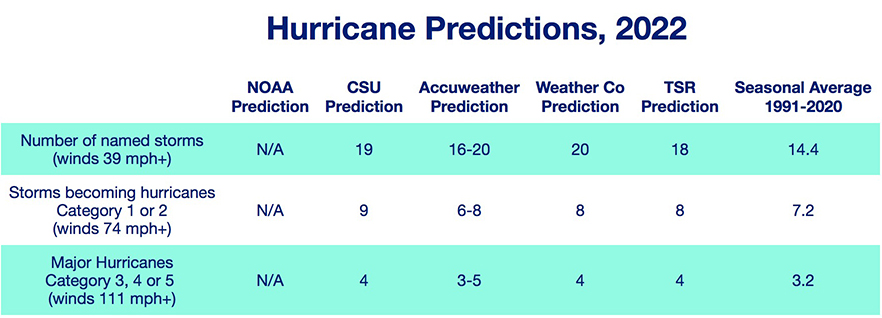Above Average Hurricane Season Predicted

The broiling Texas weather looks like it’s going to run on until Memorial Day. And as anyone who has lived in Texas knows, that’s just next door to hurricane season. Last year, Hurricanes Ida caused extensive damage to oil platforms and natural gas pipelines all over the Gulf of Mexico. And later, Hurricane Nicholas knocked out electricity in Houston and dumped over a foot of rain. So, the combination this summer of intense heat and intense storms has some Texas residents worried about what’s store for the 2022 Hurricane Season.
Back in early April, the following four weather companies released their early 2022 Hurricane predictions:
Meanwhile, the National Oceanic and Atmospheric Administration (NOAA) will announce their forecast later this month.
All four forecasts for the 2022 season predict “above average activity”. Specifically, the Atlantic Ocean, including the Caribbean and the Gulf of Mexico, will produce about 18 named tropical storms. Of these, 8 will grow to become hurricanes and of those about 4 could become major hurricanes. Now, if that’s a little eyebrow raising, it should be. That’s because while the revised seasonal average shows 14.4 tropical storms, the previous seasonal average from 1981-2010 was only 12 tropical storms. So, in a little over 35 years, the average yearly number of tropical storms in the Atlantic has nearly doubled.
So, what’s making your Texas summer so stormy?
Predictions for Water Temperatures
To begin, most of these forecasts were released in early April. At the time, sea surface temperatures (SSTs) were below 80°F for most of the tropical Atlantic. This includes the span of ocean between west Africa and the eastern Caribbean islands knowns as the Main Development Area (MDR). However, there were warmer than average SSTs in the Caribbean and the Atlantic along the eastern seaboard. But, in the month since, ocean temps in the tropical Atlantic have also warmed considerably. Currently, the Atlantic is very warm and SSTs from the Gulf of Mexico all the way to the west African coast are running between 79 and 82°F. Likewise, warm SSTs are extending much further north this year. Ocean temperatures between 68 and 72 extend all the way from the Jersey shore across the Atlantic to the Straits of Gibraltar.
That is a lot of warm water and it’s only mid-May!
Why Warm Water Matters for Hurricane Season
Basically, you can’t have a tropical storms without heat. Oceans are vast heat sinks, storing lots of heat energy that they absorb from the sun. Hurricanes tend to form when the SSTs are at least 80°F (26.5°C) down to a depth of about 150 feet. (46 m). When these storms build, they feed on both heat and moisture from water evaporating from the surface of the ocean. That’s why the more warm water they have, the bigger the monster they can become.
It doesn’t take much to disrupt this process, though. The Saharan Air Layer (SAL) is a layer of dry, dusty air at about 5,000 and 20,000 feet up in the sky. It usually forms in the late spring/early summer when hot dry winds blow across the Sahara desert and move over the Atlantic Ocean. The SAL can carry LOTS of dust, enough to be spotted from space. In 2020, the SAL scooped up a large plume of dust and deposited it in the southern U.S. This dust has been blamed for allergy problems for Texans. All this dust can prevent tropical storms and hurricanes because the dry dust blocks sunlight from warming the ocean.
Ironically enough, a recent study on tropical cyclones suggests that air pollution controls in the northern hemisphere over the past 40 years may have actually helped increase hurricanes. This is because air pollution controls reduces the amounts of particles in the air that block sunlight, allowing ocean water to warm up more. That means that smog, smoke, and soot from cars, fossil fuel electricity generators, and factories might have kept oceans just cool enough by blocking sunlight over the oceans. And this might have helped reduce tropical storms and hurricanes during the first half of the 20th Century.
How La Niña Effects Texas Hurricane Season
This past winter, a La Niña had formed in the equatorial Pacific Ocean. A La Niña is part of the El Niño Southern Oscillation (ENSO) system. The ENSO system shows how changes in the ocean can affect and change what goes on in the atmosphere. While an El Niño brings warm water to Pacific, a La Niña brings cold water. And when the water is neither warm nor cold, it’s called ENSO Neutral.
Because the Pacific is such a large ocean, huge areas with above normal or below normal water temperatures can affect how the atmosphere circulates around the world. This is why La Niña tends to bring cold winter weather to the U.S. north but mild weather to Texas. In the summer, it tends to shift the Walker Circulation along the Equator in the Pacific to the west. When that happens, there’s less churn in the atmosphere over the Caribbean that causes wind shear. A similar process happens during ENSO Neutral.
Shear Power
For a hurricane, wind shear is a death sentence. Hurricanes are giant columns that pull heat in from below and blow it out at the top. They work best when they stand straight. However, wind shear distorts the shape of a hurricane by blowing the storm column out of alignment. It’s a lot like blowing out a birthday candle in slow motion. As a result, the storm vortex has a harder time moving heated air through the column when it’s tilted. The more it tilts, the less heated air moves up through the column. When the storm can no longer move enough heated air it just fizzles out.
But because La Niña moves the wind shearing out of the way, Atlantic Hurricanes have a better chance of forming and growing. Unfortunately for Texans, the current La Niña is likely to hang around throughout the summer and then warm up to ENSO Neutral in August. That’s right at the storm season peak.
And by the way, ENSO Neutral conditions have factored into every single Texas hurricane season for the past 5 years.
When Is The Next Hurricane Going To Hit Texas?
No one can say with certainty when a hurricane will hit Texas. Fortunately for now and in spite of the hot weather, the National Hurricane Center is showing no tropical cyclone activity in the Atlantic or the Gulf of Mexico. Of course, that could change. And it only takes one storm to create a disaster.
Get Hurricane Ready Now!
In the past five years, Texas has suffered direct hits during hurricane season. While this season isn’t any more dangerous than the last, it isn’t likely going to be any safer. Because we want everyone to stay safe and healthy, we urge everyone to prepare for this summer’s hurricane season now:
- Make a plan! Work out with your family what to do so when a tropical storm heads for Texas.
- Keep in mind that Covid-19 variants remain a public health threat. Be sure to keep your family members up to date on vaccinations and boosters.
- Get this Hurricane Safety Checklist to help you keep track of how to prepare and what supplies you’ll need if you choose to shelter in place.
- Build your hurricane kit.
Sheltering in place is an option up to a point because hurricane winds can be incredibly dangerous:
- Coastal areas are seeing higher and more devastating storm surges.
- Look out for intense flooding when powerful hurricanes move far inland.
- High winds can still cause enormous damage especially to trees and power lines. Your Texas electricity service could go out for hours or even days.
Gather essential stuff for your grab ‘n’ go bag. Each person (and pet) should have their own grab ‘n’ go bag if you have to leave your home.
Know when to go! If you live in a coastal area, know and understand your Texas evacuation routes ahead of time. Make arrangements well ahead of time where you’ll go to in the event of an evacuation order.

